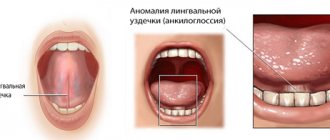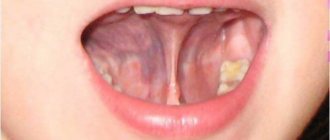Impact of frenulum pathology
Problems with speaking
But sometimes a child has a congenital pathology - shortened frenulum .
Such a diagnosis means that the frenulum is not attached in the middle of the tongue, but much closer, at the tip. Sometimes it lasts until the very tip, and the tongue even slightly bifurcates from its pressure. A serious pathology is diagnosed after the birth of a child by a neonatologist, and minor deviations in the length of the frenulum can be detected in preschool age, when the child begins to have problems pronouncing certain sounds.
Problems with breastfeeding
In infancy, a shortened frenulum can interfere with breastfeeding, as the baby cannot grasp the nipple comfortably, often loses it, and may even experience pain when sucking. This negatively affects the child’s weight gain and causes a lot of unpleasant moments for the whole family.
Indications and contraindications
Cutting the frenulum in children is resorted to in cases where:
- there are difficulties with breastfeeding;
- Speech defects and dental problems are observed.
Trimming the upper lip frenulum in children is recommended by dentists at the age of 6-8 years, when all four front incisors have fully erupted. But a short frenulum of the tongue can be operated on even in a newborn.
Among the contraindications:
- increased body temperature;
- decreased hemoglobin;
- purulent-inflammatory processes in the oral cavity.
If you have a polyvalent allergy to anesthetic drugs, surgery is contraindicated.
Tongue frenulum surgery
At what age should a tongue tie be operated on?
In infancy, the frenulum looks like a thin membrane and has no blood vessels or nerve endings. Plastic surgery is performed with one movement of a scalpel without anesthesia and subsequent treatment. After this simple procedure, the mother just needs to give the baby the breast; mother's milk will prevent any hygienic problems in the incision area. But this procedure may negatively affect future tongue movements due to the resulting scar. Therefore, if it is possible to avoid such a procedure, it is better to postpone the resolution of the issue to a later date.
For the mother, the main thing in this situation is to establish the process of breastfeeding.
With age, the membrane becomes stronger, blood vessels appear in it, and it is no longer possible to correct this as simply as in infancy. Usually, at a later age, a shortened frenulum is discovered during an appointment with a speech therapist, pediatrician or dentist. Signs of this phenomenon may include problems with speech, since the baby cannot make sounds that require touching the tip of the tongue to the palate or teeth. He begins to burr or lisp. Parents may also notice that the child has problems sticking his tongue out of the mouth.
Doctors recommend waiting until surgery
If a slightly shortened frenulum is detected, even at an early age, doctors recommend waiting until surgery. It can lengthen on its own as it grows.
Plastic surgery – frenuloplasty
But if this did not happen before primary school, a full-fledged plastic surgery called frenuloplasty is required. It is done under general or local anesthesia, depending on the perseverance and age of the child. The operation itself is extremely simple and does not take long, so if possible it is better to limit yourself to local anesthesia. The frenulum is cut at the tongue and moved a little further, and then sutured to functional size.
Postoperative period
The postoperative period at this age, unfortunately, requires special oral care, sometimes even taking antibiotics. The stitches are removed within a week. Once the incision and suture sites have completely healed, a long period of exercise with a speech therapist is required to ensure that the child develops proper language skills.
If a child is diagnosed with a shortened frenulum of the tongue, do not rush into action.
Early excision, although seemingly simpler, may cause speech problems later. Therefore, first, find a good pediatrician and consult to choose the optimal age of the small patient. And remember, such a problem can be solved in any case, it is only important to choose the method you need.
If you have any doubts about your child’s tongue frenulum, come to the A.Dent children’s clinic, here you will receive a comprehensive consultation and, if necessary, a course of treatment will be prescribed.
Short frenulum of the tongue in a child
The lingual frenulum is a fold of the oral mucosa that connects the floor of the mouth to the undersurface of the tongue. The frenulum of the tongue performs a very important function - it fixes the tongue to the soft tissues of the oral cavity, preventing tongue retraction.
Normally, the frenulum stretches from the middle of the lower surface of the tongue, but in some cases the structure of the frenulum is disrupted, thereby shortening it, that is, the upper end of the frenulum is not in the middle, but at the tip of the tongue. Anomaly of the frenulum of the tongue requires observation and even treatment.
You can see a shortened frenulum of the tongue with the naked eye; the following signs indicate it:
- low mobility of the tongue (the child cannot lift the tongue or stick it out);
- bifurcation of the tip of the tongue (a short frenulum pulls the tip of the tongue);
- difficulty feeding in infancy (the baby cannot properly latch onto the mother's nipple or bottle).
Untimely treatment of a shortened frenulum can lead to many consequences, the main ones being:
- the formation of unclear speech, difficulties begin when pronouncing sounds;
- deformation of the lower teeth and lower jaw;
- spaces between teeth;
- malocclusion.
It is recommended to trim the frenulum of the tongue for a child from birth to one year. As a rule, the problem of a short frenulum of the tongue should be noticed in the maternity hospital during the examination of a newborn, when it is much easier to trim it than at an older age. But this does not always become noticeable to the surgeon immediately, so the problem appears already in preschool age, when the child begins to have a clear deviation in speech.
The operation to cut the short frenulum of the tongue should be performed by a dentist. There are several different types of surgery, depending on the age of the child and each specific case:
For babies.
The most suitable age for correcting a frenulum is from 0 to 9 months; it is during this period that the frenulum does not have nerve endings, which makes it easier to carry out the procedure without anesthesia. As a rule, babies undergo a frenotomy - they cut across the skin fold with scissors or a scalpel. In this case, no stitches are required.
For children from 9 months to 5-6 years.
After 9 months, the frenulum thickens, so surgery will require painkillers and possible sutures.
For school-age children and teenagers.
Surgery for older children is more complex as it requires local anesthesia and stitches. After a couple of weeks, the stitches are removed. The postoperative period requires some diet to restore the sutures.
Today, cutting the frenulum of the tongue with a laser has become popular; the procedure takes only one step and does not cause any discomfort. Only a specialist can assess which method of operation will be needed in each specific case.
Short frenulum of the upper lip in a child
The problem of oral frenulum occurs quite often.
According to statistics, their frequency is approximately 10 percent of children. If not diagnosed in a timely manner, they can cause a lot of difficulties for the child in the future. And the consequences are very serious. After all, bridles can make adjustments not only to appearance, changing the aesthetics of the face and smile for the worse, but also significantly affect speech functions and the ability to eat normally. Therefore, it is very important to promptly notice this disorder in a child and seek medical help.
There are three frenulums in the oral cavity, each of these frenulums is a small cord. Despite their small size, they can have a big impact on a baby’s daily life.
With their help, to a large extent, the child is nourished, the oral mucosa is maintained in normal condition, and most sounds are correctly and clearly pronounced. To a certain extent, frenulums can affect the degree of bite. And, of course, the appearance of the baby’s face also depends to a large extent on the condition of the frenulum.
Specifically, bridles are:
- upper lip. It performs a connecting function between the upper lip and the gum located on the upper jaw. Its weaving occurs above the front incisors located in the dentition;
- lower lip. Its attachment occurs similarly to the upper lip, the principle is the same, but on the lower jaw;
- language. In its structure and functions, this bridle is more complex than other bridles. This is what parents most often have questions about. But not because problems with it occur more often, but only because parents mistakenly believe that it is the only frenulum of its kind in the child’s mouth. The frenulum connects the tongue and the sublingual area.
First aid
The international classification of diseases ICD-10 classifies the short frenulum not as a disease, but as an anatomical feature of intrauterine development, and assigns code Q38.0 “Congenital anomalies of the lips.” A rupture of the child's upper lip frenulum requires parents to perform several assistance procedures before the ambulance arrives.
- Rinse the injury with cold or cool boiled water, and if possible, inspect where the tissue may have been torn.
- Stop the bleeding. Every home medicine cabinet contains a bottle of hydrogen peroxide, which can clog blood vessels and stop capillary bleeding. Soak a piece of bandage, a cotton pad or a cotton swab with peroxide and apply it to the damaged area. The child may be frightened by the rapid formation of foam; you should be patient, take him in your arms, and calm him down. Ice or frozen foods in the freezer will help cool the area of the tear, stopping the bleeding. Apply ice wrapped in a clean cloth on the outside of your mouth to avoid cold burns. If the red border of the lips is torn, the wound should be treated with brilliant green after stopping the bleeding.
- If the injury is minor or there is no opportunity to visit a doctor, the mother treats the wound with antiseptic drugs (furatsilin solution or oil chlorophyllipt, miramistin spray) and monitors oral hygiene. Care consists of frequent hand washing if the baby has the habit of holding them in the mouth, toys, and careful brushing of teeth. It is necessary to make an appointment with a doctor for a professional examination.
- If the injury is serious, the child has torn the mucous membrane, torn it off on one side or the other, you need to contact a doctor as soon as possible. If a visit to a medical facility is postponed, the child will experience pain when chewing, swallowing, talking, or smiling, which will lead to wound infection, speech defects, facial deformities, an ugly smile, and problems with chewing. Such injuries are sutured to avoid the complications described above.
Torn frenulum
It often happens when a child, injuring the upper lip, causes damage to the frenulum - it ruptures. In such a situation, you should immediately seek help from a doctor. Not only to treat the wound, but also to avoid complications when the frenulum heals on its own.
After all, without proper surgical treatment, there is no guarantee that the frenulum will heal correctly and not asymmetrically. In addition, a rough scar will appear, which will limit the mobility of the lip. And this, in turn, will lead to speech impediment. After such an injury, the child will need to be taught exercises that will promote the mobility of the organ responsible for articulation and allow the frenulum to be slightly lengthened.
Possible consequences
Often minor damage does not cause any unpleasant consequences. The same thing applies if the mucous membrane has been restored to its normal state. If medical correction has not been carried out, the tissues have grown together incorrectly, this can cause problems as a person grows and in his later adult life:
- problems with pronouncing certain sounds, especially if the injury occurred before the baby first spoke;
- susceptibility to infections of the oral cavity, if the tissues have grown together crookedly, there is no normal oral hygiene;
- Gastrointestinal problems can occur due to the fact that children do not chew food well after gum injuries.
Kids are active and curious, they require the attention and responsible attitude of adults. Childhood injuries happen everywhere; the frenulum can tear even from excessive efforts when brushing teeth or a minor bruise; only the doctor decides whether to stitch it up or not. Many speech therapists do not see a connection between such damage and poor diction. Parents should not be afraid of a protruding lip after surgery. A child can even tear the mucous membrane several times; the main thing is not to panic and maintain a reasonable approach to the treatment and prevention of injury.
Treatment options
If the clinical indications for surgery are painful attachment to the breast and small weight gains, in infants the frenulum is dissected in its center. This simple operation is called frenotomy. How does it go? The parent holds the baby's head, the doctor lifts and fixes the tongue, and then begins the operation itself. A big advantage of frenotomy is that there is no need for anesthesia or sutures. After cutting the hyoid frenulum, the baby can be immediately applied to the breast.
Z-plasty is a more complex operation that requires local anesthesia and suturing. The choice of pain relief method depends on the child’s physical health, his age and emotional state. General anesthesia is usually used when working with children under 5 years of age with a labile psyche.










